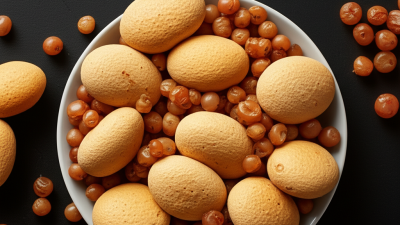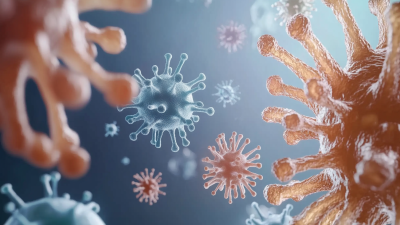Understanding the Impact of Diet on Yeast Infection Treatments and Prevention
When it comes to maintaining overall health, the importance of diet cannot be overstated, especially regarding yeast infections. A balanced and nutrient-rich diet plays a crucial role in not only preventing yeast infections but also enhancing the effectiveness of yeast infection treatments. Understanding the intricate connection between dietary choices and yeast overgrowth is essential for individuals seeking to navigate these infections more effectively. By incorporating specific foods that support a healthy microbiome and eliminating those that may exacerbate the problem, individuals can make significant strides in both treatment and prevention. This guide will delve into the fundamental aspects of how dietary habits influence yeast infection treatments and provide actionable tips to optimize one's diet for better health outcomes.

The Role of Probiotics in Diet for Yeast Infection Management
Probiotics play a crucial role in managing yeast infections through dietary interventions. These beneficial bacteria help maintain a healthy balance of microorganisms in the body, particularly in the gut and vaginal flora. By competing with pathogenic yeasts like Candida, probiotics can diminish their overgrowth and restore equilibrium. Including probiotic-rich foods such as yogurt, kefir, and fermented vegetables in one's diet can bolster this protective effect, potentially reducing the recurrence of infections.
Additionally, the effectiveness of probiotics can be enhanced by a balanced diet that limits sugar and refined carbohydrates, as these foods can promote yeast proliferation. Incorporating fiber-rich foods can also support gut health, fostering a conducive environment for beneficial bacteria to thrive. The synergy between probiotics and a healthy diet not only aids in the prevention of yeast infections but also contributes to overall well-being, making dietary choices an essential part of yeast infection management strategies.
Understanding the Impact of Diet on Yeast Infection Treatments and Prevention - The Role of Probiotics in Diet for Yeast Infection Management
| Dietary Component | Impact on Yeast Infection | Probiotic Sources | Recommended Daily Intake (for adults) |
|---|---|---|---|
| High-Fiber Foods | Promotes healthy gut flora, reducing yeast overgrowth | Fruits, Vegetables, Whole Grains | 25-30 grams |
| Fermented Foods | Enhances probiotic levels, supports immune function | Yogurt, Sauerkraut, Kimchi | 1-2 servings per day |
| Sugar Reduction | Decreases food source for yeast, reducing infection risk | N/A | Limit added sugars to <10% of total calories |
| Garlic | Antifungal properties, may combat yeast infections | Fresh Garlic, Garlic Supplements | 1-2 cloves per day |
| Omega-3 Fatty Acids | Supports immune response, potentially lowering infection rates | Fatty Fish, Flaxseeds, Walnuts | 250-500 mg of EPA and DHA combined |
Essential Nutrients to Incorporate in Your Daily Diet for Prevention
A balanced diet plays a crucial role in supporting the immune system, which can help prevent and manage yeast infections. Incorporating essential nutrients into your daily meals is fundamental for maintaining overall health and keeping fungal overgrowth at bay.
Foods rich in vitamin C, such as citrus fruits and leafy greens, boost the immune response by enhancing the production of white blood cells. Additionally, probiotics found in yogurt and fermented foods like kefir can promote a healthy balance of gut flora, which may hinder yeast proliferation.
In addition to vitamins and probiotics, it’s important to include healthy fats, such as those from avocados, nuts, and olive oil, in your diet. These fats support cellular integrity and can help reduce inflammation, which is often exacerbated by yeast infections. Furthermore, whole grains and legumes provide essential fibers that nourish beneficial gut bacteria. By focusing on a diet abundant in these nutrients, individuals can create an environment less conducive to yeast infections, leading to improved treatment outcomes and better overall health.
Foods to Avoid: Reducing Sugar and Refined Carbs to Combat Yeast
Diet plays a crucial role in managing and preventing yeast infections, particularly through the foods we consume. One of the most significant dietary adjustments involves reducing the intake of sugar and refined carbohydrates. These foods serve as a primary fuel source for yeast, promoting its growth in the body. When sugar and refined carbs are consumed in excess, they can lead to an imbalance in the natural flora, allowing yeast to thrive and potentially leading to infections.
Avoiding sugary snacks, pastries, and soft drinks is essential for anyone looking to combat yeast infections. Similarly, refined carbohydrates found in white bread, pasta, and many processed foods can contribute to elevated blood sugar levels, exacerbating the problem. Opting for whole grains, vegetables, and healthy fats can help maintain stable blood sugar levels and provide the body with the nutrients needed to support a balanced microbiome. By making these dietary changes, individuals can significantly reduce their risk of developing yeast infections and support their overall health.
Hydration: The Importance of Water in Supporting Immune Health
Hydration plays a crucial role in supporting immune health, significantly influencing the body's ability to fend off infections, including yeast infections.
Adequate water intake helps maintain the mucosal membranes, which act as the first line of defense against pathogens. When the body is well-hydrated, the immune system functions more efficiently, facilitating the transportation of nutrients and oxygen needed for immune cell production and activity.
Moreover, water aids in the natural detoxification processes of the liver and kidneys, which are vital for removing excess sugars and toxins from the body that could otherwise encourage yeast overgrowth. Staying hydrated can also help balance the body's pH levels, creating a less favorable environment for yeast to thrive.
Therefore, prioritizing hydration not only boosts immune health but also serves as a preventive measure against yeast infections, highlighting the interconnectedness of diet, hydration, and overall well-being.
Meal Planning Strategies for a Diet that Fights Yeast Infections
Meal planning plays a crucial role in both preventing and treating yeast infections, as dietary choices can significantly influence the growth of yeast in the body. A well-structured diet that limits sugar intake and incorporates anti-fungal foods can support the immune system in combating infections. Foods such as garlic, coconut oil, and leafy greens have natural anti-fungal properties that help to create an environment less favorable for yeast proliferation. Including high-fiber foods in meals also aids in maintaining a healthy gut microbiome, which is essential for keeping yeast levels in check.
Incorporating consistent meal planning strategies is essential for individuals dealing with yeast infections. This could involve preparing meals in advance, focusing on whole, unprocessed foods, and avoiding refined carbohydrates, which can lead to spikes in blood sugar. Adopting such dietary habits not only curtails yeast growth but also parallels successful strategies seen in managing other conditions like diabetes. Similar to reversing type 2 diabetes through proper nutrition and lifestyle choices, a balanced diet can serve as a powerful tool in the proactive management of yeast infections, fostering overall health and wellness.
Related Posts
-

Challenges Associated with Infection and Pain Management in Healthcare
-

Unmatched Excellence: China's Leading Role in Exporting Top Yeast Infection Treatments
-

Unlocking the Advantages of Best Antibiotic Resistant Bacteria for Advanced Healthcare Solutions
-

Your Guide to Sourcing Reliable Manufacturers for Wound Pain Relief Medicines
-

Top 10 Pain Relief Medications Manufacturers from China at the 137th Canton Fair
-

Establishing Industry Standards: How to Choose the Best Allergic Reaction Medicine for Your Needs
